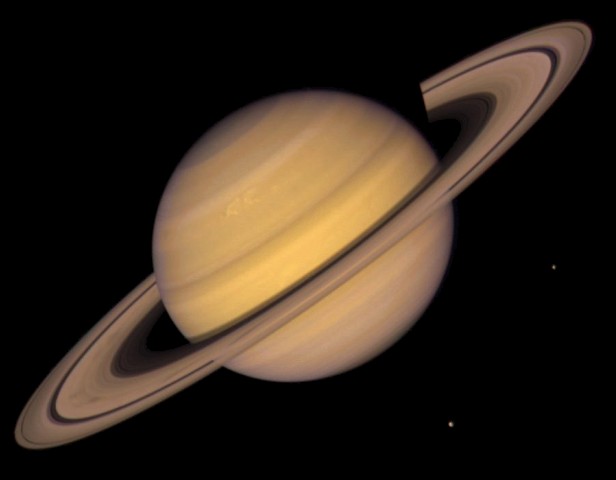
The material which forms the rings is less than 0.1% the amount
of material in either moon.
| Orbital Elements | ||
| Mean distance from Sun | 1,429,400,000 km | = 9.5388 astronomical units |
| Perihelion distance | 1,352,550,000 km | = 9.0412 astronomical units |
| Aphelion distance | 1,514,500,000 km | = 10.1238 astronomical units |
| Eccentricity of orbit | 0.0560 | |
| Inclination of orbit | 2.488° | relative to Earth's orbit |
| Period of orbit | 29.458 years | |
| Synodic period | 378 days | relative to Earth |
| Mean orbital speed | 9.67 km/s | |
| Minimum orbital speed | 9.09 km/s | |
| Maximum orbital speed | 10.18 km/s | |
| Physical Properties | ||
| Mean diameter | 116,464 km | = 9.2 Earth diameters |
| Equatorial radius | 60,268 km | |
| Polar radius | 54,364 km | |
| Oblateness | 1/9 | |
| Mass | 5.688 x 1026 kg | = 95.181 Earth masses |
| Mean density | 0.69 g/cm3 | |
| Rotational period | 10.233 hours | |
| Inclination of axis | 25.33° | relative to the axis of its orbit |
| Gravity at cloud tops | 9.05 m/s2 | |
| Escape speed | 35.5 km/s | from cloud tops |
| Visual geometric albedo | 0.47 | |
| Visual magnitude (Vo) | 0.67 | maximum, as seen from Earth |
| Mean visible cloud temperature | -125°C | |
| Atmospheric pressure | 1.4 bars | at cloud tops |
| Atmospheric Composition | |
| Hydrogen (H2) | 96.3% |
| Helium (He) | 3.25% |
Moons
![]()
One large moon, four medium-size moons, and more than two dozen small moons.
 To my Space and Science home page
for more about the Solar System
To my Space and Science home page
for more about the Solar System
Jeff Root
September 4, 2003